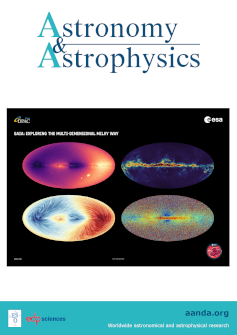Presenting 28 years of Sun-as-a-star extreme ultraviolet light curves from SOHO EIT
IF 5.8
2区 物理与天体物理
Q1 ASTRONOMY & ASTROPHYSICS
引用次数: 0
Abstract
Context. The Solar and Heliospheric Observatory (SOHO) Extreme-ultraviolet Imaging Telescope (EIT) has been taking images of the solar disk and corona in four narrow extreme ultraviolet (EUV) bandpasses (171 Å, 195 Å, 284 Å, and 304 Å) at a minimum cadence of once per day since early 1996. The time series of fully calibrated EIT images now spans approximately 28 years, from early 1996 to early 2024, covering solar cycles 23 and 24 in their entirety, as well as the beginning of cycle 25.Aims. We aim to convert this extensive EIT image archive into a set of “Sun-as-a-star” light curves in EIT's four bandpasses, observing the Sun as if it were a distant point source viewed from a fixed perspective.Methods. To construct the light curves, we summed the flux in each EIT image into one flux value, with an uncertainty accounting for both the background noise in the image and the potential spillover of flux beyond the bounds of the image (which is especially important for the bands with significant coronal emission). We corrected for long-term instrumental systematic trends in the light curves by comparing our 304 Å light curve to the ultraviolet light curve taken by SOHO's CELIAS/SEM solar wind monitoring experiment, which has a very similar bandpass to the EIT 304 Å channel. We corrected for SOHO's viewing angle by fitting a trend to the flux values with respect to SOHO's heliocentric latitude at the time of each observation.Results. We produced two sets of Sun-as-a-star light curves with different uncertainty characteristics, available for download from Zenodo, either of which might be preferred for different types of future analyses. In version (1), we treated the EIT instrumental systematics consistently across the entire SOHO mission lifetime, producing a light curve with approximately homoscedastic uncertainties. In version (2), we only divided out the EIT instrumental systematics from November 12, 2008, onward; this is the point at which these systematics start to have a noticeable deleterious effect on the data. Therefore, version (2) has heteroscedastic uncertainties, but these uncertainties are much smaller than the version (1) uncertainties over the first half of the mission.Conclusions. We find that our EUV light curves trace the Sun's ∼11-year solar activity cycle and ∼27-day rotation period much better than comparable optical observations. In particular, we can accurately recover the solar rotation period from our 284 Å light curve for 26 out of 28 calendar years of EIT observations (93% of the time), compared to only 3 out of 29 calendar years (10% of the time) for the VIRGO total solar irradiance time series, which is dominated by optical light. Our EIT light curves, in conjunction with Sun-as-a-star light curves at optical wavelengths, will be valuable to those interested in inferring the EUV/UV character of stars with long optical light curves, but no intensive UV observations, as well as to those interested in long-term records of solar and space weather.展示SOHO EIT 28年来太阳作为恒星时的极紫外光曲线
上下文。自1996年初以来,太阳和日光层天文台(SOHO)极紫外成像望远镜(EIT)一直以每天最少一次的频率,在四个狭窄的极紫外(EUV)波段(171 Å, 195 Å, 284 Å和304 Å)拍摄太阳盘和日冕的图像。完全校准的EIT图像的时间序列现在跨度约为28年,从1996年初到2024年初,涵盖了整个太阳活动周期23和24,以及太阳活动周期25的开始。我们的目标是将这些广泛的EIT图像档案转换为一组在EIT的四个带通中“太阳作为恒星”的光曲线,从固定的角度观察太阳,就好像它是一个遥远的点光源。为了构建光曲线,我们将每张EIT图像中的通量求和为一个通量值,其不确定性既考虑了图像中的背景噪声,也考虑了图像边界之外的潜在通量溢出(这对于具有显著日冕发射的波段尤为重要)。通过将304 Å光曲线与SOHO的CELIAS/SEM太阳风监测实验所获得的紫外线光曲线进行比较,我们对光曲线的长期仪器系统趋势进行了校正,该曲线与EIT 304 Å通道具有非常相似的带通。我们通过拟合通量值在每次观测时相对于SOHO日心纬度的趋势来校正SOHO的视角。我们制作了两组具有不同不确定性特征的太阳恒星光曲线,可以从Zenodo下载,其中任何一组都可能是未来不同类型分析的首选。在版本(1)中,我们在整个SOHO任务寿命期间一致地处理了EIT仪器系统,产生了具有近似均方差不确定性的光曲线。在版本(2)中,我们只划分了2008年11月12日以后的EIT仪器系统;在这一点上,这些系统开始对数据产生明显的有害影响。因此,版本(2)具有异方差不确定性,但这些不确定性远小于版本(1)在任务前半段的不确定性。我们发现我们的EUV光曲线追踪太阳的~ 11年的太阳活动周期和~ 27天的自转周期比可比的光学观测要好得多。特别是,我们可以从284 Å光曲线中准确地恢复太阳自转周期,在EIT观测的28个日历年中有26个日历年(93%的时间),相比之下,处女座的太阳总辐照度时间序列在29个日历年中只有3个日历年(10%的时间),主要是光学光。我们的EIT光曲线,连同太阳作为恒星的光曲线在光学波长上,对于那些有兴趣推断具有长光学光曲线的恒星的EUV/UV特征,但没有密集的紫外线观测,以及那些对太阳和空间天气的长期记录感兴趣的人来说,将是有价值的。
本文章由计算机程序翻译,如有差异,请以英文原文为准。
求助全文
约1分钟内获得全文
求助全文
来源期刊

Astronomy & Astrophysics
地学天文-天文与天体物理
CiteScore
10.20
自引率
27.70%
发文量
2105
审稿时长
1-2 weeks
期刊介绍:
Astronomy & Astrophysics is an international Journal that publishes papers on all aspects of astronomy and astrophysics (theoretical, observational, and instrumental) independently of the techniques used to obtain the results.
 求助内容:
求助内容: 应助结果提醒方式:
应助结果提醒方式:


